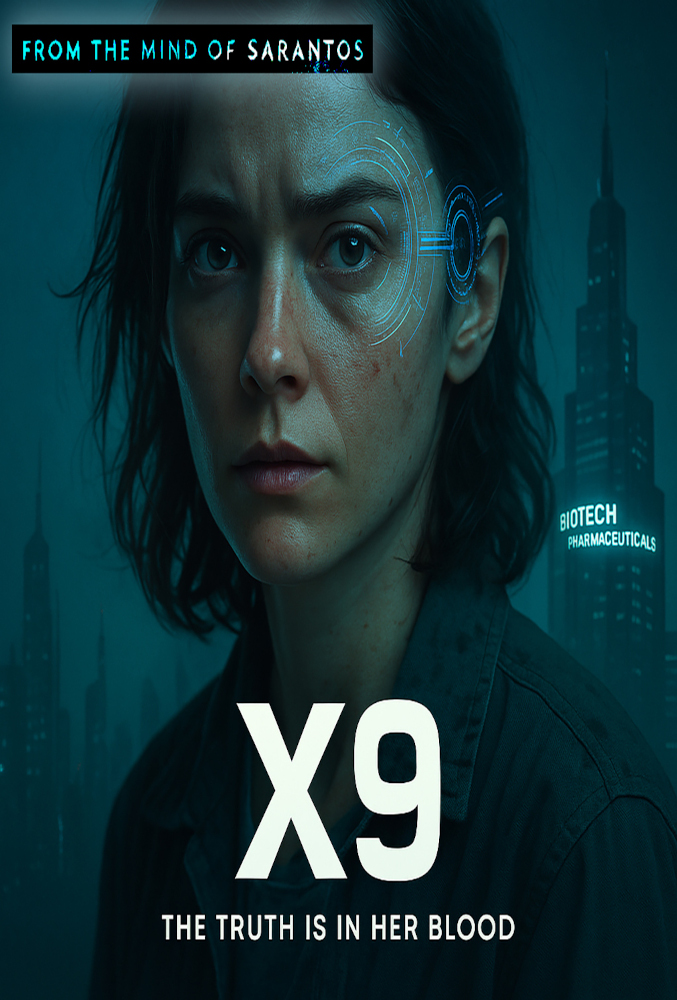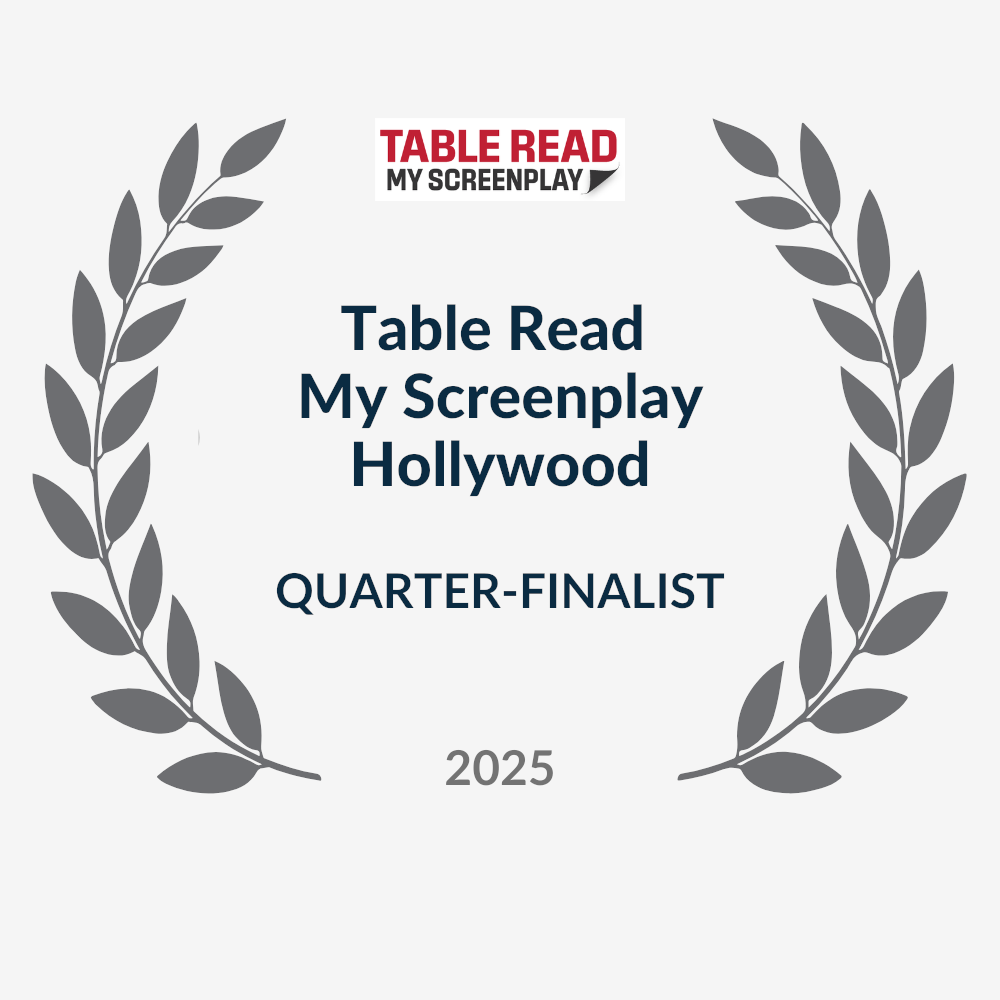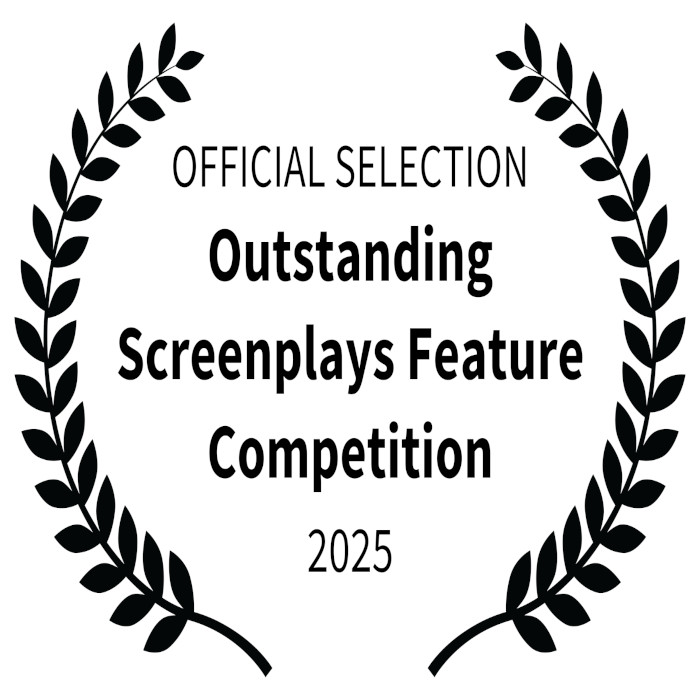
Sarantos Screenplay: X9

Logline:
When a brilliant outcast scientist uncovers a pharmaceutical giant’s deadly secret, she must go on the run and risk everything to expose the truth—facing a world that sees her as the villain and a system built to erase her before she can spark a global reckoning.
Genre
Science Fiction Thriller (Sci-Fi Thriller)
Subgenres:
- Biopunk / Near-Future Sci-Fi
- Corporate Conspiracy
- Medical Thriller
- Dystopian Morality Tale
- Female-Led Rebellion / Hero’s Journey
Why This Fits:
- Tone: Dark, urgent, and grounded in real-world anxiety—memory loss, viral trauma, and corporate overreach. It balances cerebral tension with emotional stakes, anchored by a driven female lead battling internal and external collapse.
- Structure: Classic thriller architecture—Act I introduces the system and its cracks; Act II spirals into betrayal, action, and rising costs; Act III forces a moral choice that carries irreversible global consequences.
- Characters: Andrea is a morally complex protagonist shaped by grief, intellect, and fury. Her allies are ideologically aligned but fractured, while her antagonist (Gupta) operates with chilling control and manipulative power.
- Worldbuilding: A chillingly plausible near-future where memory is currency, science is weaponized, and truth is buried under pharma profit. The X9 virus, corporate secrecy, and digital warfare are all genre-defining elements.
In Studio Terms:
If you pitched it to studios or streaming platforms, you would call it:
"A grounded Sci-Fi Thriller with biopunk and conspiracy elements."
Or simply:
"Sci-Fi Thriller in the spirit of Children of Men meets The Constant Gardener."
Awards




Synopsis
In a near-future world ravaged by the memory-wiping virus X9, brilliant young scientist Andrea Santiago discovers a suppressed cure hidden by the powerful Biotech Pharmaceuticals. Having once been recruited into the system she now seeks to dismantle, Andrea grapples with betrayal, moral compromise, and the overwhelming cost of truth.
After the death of her mentor, Dr. Brown, Andrea pieces together the reality behind X9’s synthetic design: it was built for control, not healing. With allies like the determined activist Karen Farris and the rebellious insider Regan Brown, Andrea launches a daring operation to expose Biotech’s corruption and unleash the cure to the world.
Standing in her way is the ruthless CEO Dr. Raj Gupta, who offers Andrea fame and power if she joins him—but Andrea refuses, even as the virus ravages her body. As social order collapses and public panic rises, Andrea risks her life to deliver the cure, facing betrayal, loss, and her own physical deterioration. In a final act of defiance, she leaks irrefutable evidence of Biotech’s crimes, restoring hope just as she teeters on the edge of collapse.
Ultimately, X9 is a story about sacrifice, memory, and the relentless pursuit of truth—even when the mind and body begin to fail.
Comps
Comp #1 (Two Films):
It’s Children of Men meets The Constant Gardener.
A gritty, near-future thriller that blends high-stakes conspiracy with grounded emotional urgency—centered on a lone protagonist battling personal decay and institutional collapse in equal measure.
Comp #2 (Film + Genre Element):
It’s Ex Machina with the viral paranoia of Contagion.
Sci-fi grounded in biotech and memory science, with sleek, minimalist tension—set against the moral fog of corporate corruption and the looming fear of global systems unraveling.
Comp #3 (Streaming-Friendly Framing):
It’s Black Mirror reimagined as a cinematic feature with a singular heroine at its core.
Designed for audiences craving cerebral sci-fi grounded in human cost, X9 delivers a haunting character journey, relevant sociopolitical themes, and just enough speculative edge to feel dangerously real.
Elevator Pitch:
She’s a brilliant young scientist with a past full of secrets. They’re the most powerful pharmaceutical empire on Earth—and they’ve built their fortune on a lie.
In this high-stakes sci-fi thriller, Andrea Santiago stumbles upon a suppressed cure to a memory-wiping virus that has reshaped the world. After the mysterious death of her mentor, she’s framed, hunted, and forced to go rogue—risking her life to expose the truth buried deep within the biotech elite. As society teeters on the edge of collapse and her own memories begin to vanish, Andrea must outwit a ruthless CEO, outlive a system designed to erase her, and decide just how much she’s willing to sacrifice for a world that may never remember her name.
Think Children of Men meets The Constant Gardener, with the psychological tension of Black Mirror and the emotional punch of Arrival.
Character Conflict:
Character Conflict Summary:
Andrea vs. Biotech — and herself.
(Andrea Santiago’s internal battle between truth and survival collides with a corrupt global system determined to erase both.)
Andrea Santiago's Core Conflict:
She’s brilliant, impulsive, and emotionally scarred. Andrea is driven by a deep need to expose the truth—but her recklessness, pride, and suppressed trauma put others in danger and isolate her from the few allies she has left.
- Wound: She lost both parents to early, illegal X9 trials—a fact she’s buried under scientific obsession and emotional detachment.
- Flaw: Believes she has to fix everything alone; pushes people away, distrusts authority, and often ignores the human cost of her actions.
- Fear: That she’s already becoming what she hates—a cog in a machine that kills truth, or worse, a scientist willing to sacrifice others to prove she’s right.
Dr. Raj Gupta's Core Conflict:
He’s polished, terrifyingly composed, and utterly convinced he’s saving the world. Gupta believes humanity needs control, not chaos—and he sees Biotech as a stabilizing force, even if that means burying truths and destroying lives.
- Wound: A formative loss—possibly during a past pandemic—left him disillusioned with human nature. He sees free will as dangerous.
- Flaw: Believes he alone has the vision and intellect to maintain order.
- Fear: That if the truth spreads, humanity will spiral—and all his control will have been for nothing.
Where They Collide:
Andrea is trying to expose a lie that Gupta believes is necessary for global survival. She sees him as a monster in a lab coat. He sees her as a naïve threat to billions.
- Andrea sees Gupta as the embodiment of everything broken in science—power without conscience.
- Gupta sees Andrea as a brilliant but dangerous idealist, someone whose version of “truth” will destroy more lives than it saves.
Central Emotional Conflict:
Can Andrea hold onto her humanity long enough to save others, or will her obsession with vengeance and truth make her the villain of her own story?
Bonus Conflict Dynamics:
- Andrea mirrors Gupta in dangerous ways—they both play god, both believe they’re right, both isolate themselves in pursuit of a greater vision.
- Karen Farris (the activist) and Regan Brown (the insider) each force Andrea to confront different aspects of herself: her buried grief, her moral compromises, and her fear of intimacy or leadership.
- Andrea’s core challenge isn’t just external—she must learn to trust, to ask for help, and to lead without becoming the same cold strategist she’s fighting.
Why This Conflict Is Strong:
- It’s deeply personal (her family’s death, Brown’s betrayal, her own illness).
- It’s philosophical (freedom vs. control, truth vs. stability).
- It’s plot-driving (her early leaks nearly kill innocent people, forcing real growth).
- It’s timely and urgent—medical misinformation, tech monopolies, institutional betrayal.
One-Line Character Conflict Summary:
Andrea must overcome her need to act alone and her thirst for vengeance before she becomes the very force of control she’s trying to destroy.
Character Info:
Tailored specifically for industry listings like screenplay databases, pitch portals, or competitions.
Character Profiles:
- Andrea Santiago
Lead – Female, 20s. Brilliant. Defiant. Wounded.
Description: Andrea is a former biotech prodigy with a blistering intellect, a reckless edge, and a buried emotional core shaped by personal tragedy. Recruited into Biotech Pharma by her mentor, she discovers a devastating truth about the X9 virus—and the system that covered it up. Haunted by loss and driven by rage, Andrea is caught between her desire to expose the truth and her fear of becoming just another weaponized mind.
Character Type: Female lead with cerebral firepower, emotional complexity, and a rebellious streak.
Think: Rooney Mara in Side Effects meets Natalie Portman in Annihilation.
Arc: Andrea begins as an isolated truth-seeker with a savior complex. Through betrayal, illness, and personal sacrifice, she evolves into a leader who learns to trust, to grieve, and to act with conscience—not just fury.
Casting Notes: Ideal for an actor with precision, intensity, and the ability to play both cold intellect and aching vulnerability without speechifying.
- Dr. Raj Gupta
Lead Antagonist – Male, 50s–60s. Controlled. Visionary. Dangerous.
Description: CEO of Biotech Pharma and architect of the X9 rollout, Dr. Gupta is calm, persuasive, and utterly convinced he’s saving humanity—even if that means rewriting it. He sees Andrea not just as a threat, but as a reflection of who he once was: brilliant, uncompromising, and naive. His villainy is rooted in philosophy, not ego—he believes control is mercy.
Character Type: Cold, intellectual antagonist with conviction and presence.
Think: Christoph Waltz in Big Pharma noir meets Ben Kingsley in Sexy Beast.
Arc: Gupta doesn’t change—he reveals. His final confrontation with Andrea tests her morality more than his. The arc lives in what he forces out of others.
Casting Notes: Gravitas essential. Works best with an actor who can deliver menace through stillness, and ideology without shouting.
- Karen Farris
Supporting – Female, 30s–40s. Tenacious. Grounded. Compassionate.
Description: A community activist and former nurse whose family was devastated by the X9 outbreak, Karen serves as Andrea’s moral anchor. She is practical, emotionally intelligent, and fueled by loss—but refuses to let rage eclipse humanity. Where Andrea burns hot, Karen burns steady.
Character Type: Grounded truth-teller with deep empathy and emotional resilience.
Think: Angela Bassett in Contact meets Thandiwe Newton in Crash.
Arc: Karen doesn’t transform—she holds. Her quiet strength offers Andrea a path back to herself when she’s near collapse.
Casting Notes: Ideal for an actor who can embody quiet leadership and layered emotion without theatricality.
- Regan Brown
Supporting – Nonbinary or Female, 20s–30s. Cunning. Reserved. Fractured.
Description: Regan is Dr. Brown’s estranged child and a junior tech specialist at Biotech. They operate in the gray area—sharp, emotionally distant, but quietly haunted. Their insider status makes them a key asset, but their personal connection to Brown makes their betrayal of Biotech deeply personal.
Character Type: Conflicted insider with emotional tension and hidden loyalty.
Think: Zoë Kravitz in KIMI meets Elliot Page in Inception.
Arc: Regan begins detached and aligned with Biotech out of self-preservation. Over the course of the film, they are drawn into Andrea’s fight, ultimately making a pivotal choice that links personal grief with global action.
Casting Notes: Best suited for a performer who can carry internal conflict and quiet intensity, with subtext over speech.
Budget:
Mid-range budget for a grounded sci-fi thriller with limited VFX and a focused narrative.
Estimated Budget Category: $10M–$25M USD
This places it in the same tier as smart, socially relevant sci-fi films that blend cerebral storytelling with lean, cinematic spectacle—ideal for prestige streamer releases, festival breakouts, or international co-productions.
Why this Budget Range Works:
Primary Costs:
- Cast: One central lead (Andrea), plus 3–5 key supporting roles (Dr. Brown, Dr. Gupta, Karen Farris, Regan Brown), offering strong ensemble opportunities for recognizable talent or rising actors.
- Locations: Near-future urban settings, biotech labs, data centers, refugee zones.
- Stylized but achievable with practical locations dressed for a slightly futuristic feel.
- Avoids off-world or extensive worldbuilding—grounded in recognizable environments.
- VFX/Technology: Moderate effects budget needed for:
- UI overlays, biotech interfaces, memory-loss sequences.
- Occasional drone shots, lab tech, and surveillance environments.
- No space travel, creatures, or CGI-heavy worlds.
- Production Design: Clinical modernism—glass labs, minimalist tech, corporate dystopia aesthetic.
- Wardrobe/Look: Contemporary with subtle sci-fi flourishes—uniforms, biomasks, branded pharma gear.
Production Style:
- Contained storytelling: Limited action sequences; most tension comes from discovery, paranoia, and corporate pursuit.
- Shootable in 30–35 days with a focused unit.
- Built for international appeal: Global themes, viral fear, systemic collapse, and a determined female lead with moral complexity.
Comparable Projects:
- The East (Fox Searchlight, est. ~$6M–10M)
- Little Fish (IFC Films, est. ~$10M)
- The Constant Gardener (Focus Features, est. ~$25M)
- Upgrade (Blumhouse, est. ~$5M but more contained sci-fi)
- I Origins (Searchlight, est. ~$10M–12M)
Special Studio Note:
If shot using smart modular sets and subtle VFX enhancements—leaning into atmosphere and performance rather than spectacle—this could be made for under $15M. However, to fully realize the scale of memory decay, public panic, and systemic collapse without sacrificing polish, a $20M–$25M ceiling offers the most breathing room for premium execution.
Pitch Sheet:
Project Title:
X9
Genre:
Science Fiction Thriller
Subgenres: Biopunk · Corporate Conspiracy · Near-Future Dystopia · Female-Led Sci-Fi
Tagline:
She’s racing to expose the truth—before the virus steals her memories for good.
Elevator Pitch:
It’s Children of Men meets The Constant Gardener — a cerebral sci-fi thriller about memory, morality, and the cost of truth.
In a world reeling from a memory-erasing virus, brilliant young scientist Andrea Santiago discovers a suppressed cure buried by the powerful pharmaceutical empire that once recruited her. Framed and hunted, Andrea must go rogue to deliver the cure and expose the truth—before her own memories vanish forever.
Tone & Vibe:
Think Black Mirror with the emotional grounding of Arrival and the tension of Contagion.
Visually sleek but emotionally raw, this is a thriller where personal collapse meets global stakes. The tech is near-future, the science disturbingly plausible, and the heart is all too human.
Logline:
In a near-future devastated by a memory-wiping virus, a brilliant but wounded scientist uncovers a hidden cure—and must risk everything to expose the pharmaceutical giant protecting it, even as her own memories begin to fade.
Key Selling Points:
- Grounded sci-fi that’s both cerebral and character-driven — no flying cars, just terrifying realism.
- A strong, complex female lead — morally conflicted, emotionally guarded, and unforgettable.
- Timely themes — pandemic aftermath, institutional betrayal, medical ethics, tech monopolies.
- Visually dynamic — memory collapse sequences, biotech labs, data leaks, and dystopian tension.
- Mid-budget potential — contained locations, focused cast, limited but elegant VFX.
Primary Audience:
Fans of Black Mirror, Ex Machina, Annihilation, The Constant Gardener, Gattaca, and The Handmaid’s Tale.
Ideal for streamers like Netflix, Amazon Prime, Apple TV+, or Hulu — especially for audiences craving speculative thrillers grounded in emotional reality.
Market Positioning:
A festival-friendly prestige sci-fi thriller with a high-concept hook and emotionally intimate core. Perfect for buyers seeking female-led, socially conscious, awards-friendly content with international resonance.
Budget Category:
Mid-budget range: $10M–$25M.
Smart use of existing locations and subtle VFX allows cinematic scale without blockbuster overhead.
Lead Characters:
Andrea Santiago – 20s
A brilliant but emotionally scarred scientist with a rebellious streak, a buried trauma, and a conscience that won’t let her walk away from a system built to forget.
Dr. Raj Gupta – 50s–60s
A visionary CEO whose cold belief in order over truth drives him to bury a cure that could upend everything Biotech controls—starting with him.
Karen Farris – 30s–40s
A grassroots activist with nothing left to lose, whose loss fuels a moral clarity that challenges Andrea’s more fractured resolve.
Regan Brown – 20s–30s
An insider with split loyalties and something to prove. Cold on the outside, quietly unraveling within.
Themes:
- Memory as identity — who are you when you can’t remember who you are?
- The human cost of institutional power and medical control.
- Truth versus survival — and the cost of telling the truth when the world isn’t ready.
- Loneliness, grief, and the risk of connection in a world built on forgetting.
Why It Works for Big Studios or Streamers:
- Intellectually sharp and emotionally rich — perfect for audiences craving thoughtful sci-fi with real stakes.
- A breakout role for a rising star — or awards vehicle for a known actor seeking depth.
- Festival prestige meets commercial viability — ideal for both the indie market and streamer-backed prestige originals.
- Visually stylish, thematically urgent, and tightly contained for efficient, high-impact production.
Script:
This document is view-only for content protection.
If you’d like a personal copy to read, please email me at info@melogia.com
Follow Sarantos:
- Website: www.melogia.com
- Amazon: Sarantos on Amazon
- Author’s Guild: Author’s Guild
- BookBaby: Sarantos on BookBaby
- YouTube: SarantosMelogia
- Goodreads: Sarantos on Goodreads
- Facebook: @SarantosMelogia
- Instagram: @SarantosMelogia
- Twitter: @SarantosMelogia
- TikTok: @Sarantos




















